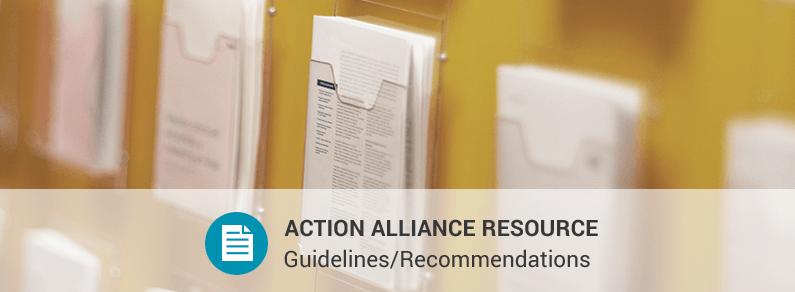Suicide is an important public health issue, and those who blog on the topic share diverse perspectives, backgrounds and experiences that can help those who are struggling. However, it’s important to note that readers’ attitudes and behaviors can be influenced by what and how bloggers write about suicide, mental health, crisis, and suicidal ideation – both negatively and positively. The following recommendations are meant to assist bloggers in blogging about suicide safely, and ultimately maximize the effectiveness of the bloggers’ efforts and reduce the risk of harmful effects of unsafe messaging on suicide.
Resource Types: Guidelines/Recommendations
Talking about suicide and LGBT populations
A second consortium of organizations held in 2017 issued revised recommendations to guide both news and social media in safe reporting of suicide events among LGBT populations. The recommendations are intended to promote vital, thoughtful public discussion about the issue and prevent contagion associated with sensational language. The guide is available in Spanish.
The Talking About Suicide & LGBT Populations guide is a community-based resource for talking about suicide in ways that minimize contagion risk while at the same time expanding public conversations about the well-being of lesbian, gay, bisexual and transgender (LGBT) people, promoting the need for family support and acceptance, and encouraging help-seeking by LGBT people who may be contemplating suicide. In addition to 12 practical recommendations on how to talk about suicide in safe and accurate ways, the guide provides information about suicide contagion, bullying and suicide, talking about suicide in social media, and research findings on suicide.
Program Objectives:
Those who read the recommendations will learn to:
1.Reduce the use of language in public communications that may increase risk of suicide contagion.
2.Increase the use of language in public communications that fosters an accurate understanding of suicide and its causes.
3.Increase awareness of, and emphasis on, the need to support the well-being of LGBT people.
Preventing Suicide: A Resource for Media Professionals – Update 2017
Updated in 2017, this resource briefly summarizes the evidence on the impact of media reporting of suicide, and provides guidelines for media professionals about how to report on suicide. It encourages caution in reporting suicide, recognizes that there are times when a suicide will need to be reported on the grounds of its newsworthiness and makes suggestions about how best to ensure that such reporting is accurate, responsible and ethical. Special considerations for digital media and mass shootings/terrorism are also included. It is accompanied by a quick guide.
The booklet is part of a series for specific social and professional groups that are particularly relevant to the prevention of suicide and is released by a continuing collaboration by the World Health Organization (WHO) and the International Association for Suicide Prevention (IASP) to address worldwide suicide.
Crisis now: Transforming services is within our reach

This Action Alliance report describes what can be done to improve suicide care in emergency departments and behavioral health crisis care in general.
Zero Suicide: An international declaration for better healthcare
This declaration was developed by a diverse group of 50 peer leaders, government policy makers, and healthcare providers from 13 countries convened for Atlanta 2015: An International Declaration and Social Movement to address the aspirational goal of zero suicide in healthcare. It discusses the problem of suicide stemming from a lack of effective care and steps healthcare organizations can take to prevent suicide deaths among their patients.
Preventing Suicide among Men in the Middle Years: Recommendations for Suicide Prevention Programs

This publication was created to help state and community suicide prevention programs design and implement projects to prevent suicide among men in the middle years (ages 35–64). It includes a review of the research, recommendations that provide guidance for state and community suicide prevention programs on addressing suicide in this population, and an annotated list of programs and resources.
Sample agency practices for responding to client suicide
These guidelines and recommendations are intended to help identify immediate responsibilities and potential resources and sources of support following a client suicide. Since every case is unique and presents its own issues, these are intended only as general guidelines, to be modified as appropriate for the individual situation.
The primary author of these sample practices, Jeffrey C. Sung, MD, is a clinical instructor at the University of Washington Department of Psychiatry and Behavioral Sciences and co-instructor of Wellspring Counseling’s “Working with Suicidal Clients” workshop. These guidelines were developed with the help of Sue Eastgard, MSW, Director of Training for Forefront: Innovations in Suicide Prevention at the University of Washington and R. Keith Myers, LICSW, Vice President of Clinical and Training Services for Wellspring Counseling. We received valuable feedback from Katherine A. Comtois, PhD; Sharon Farmer, MD; Nina Gutin, PhD, co-chair of the American Association of Suicidology’s Clinician Survivor Task Force; Glenette Olvera, LICSW; and Edward Rynearson, MD, medical director of the Violent Death Bereavement Society.
The suicide death of a client or patient is a dreaded potential outcome in mental health treatment. Death by suicide requires an agency to respond in a manner that provides support for the clinical team while fulfilling regulatory requirements. Agency responsibilities include communication within and outside the organization, reporting the death, risk management, administrative case review (morbidity/morality conference), media coverage, staff support and education. A major challenge for an agency is the balancing of potentially conflicting priorities between safety-focused administrative needs for information and staff-focused emotional needs for support.
Program Objective: organizations that use Sample Agency Practices for Responding to Client Suicide will have increased knowledge of immediate responsibilities, potential resources, and sources of support in the aftermath of a client suicide.
Sample individual practitioner practices for responding to client suicide
The primary author of these sample practices, Jeffrey C. Sung, MD, is a clinical instructor at the University of Washington Department of Psychiatry and Behavioral Sciences and co-instructor of Wellspring Counseling’s “Working with Suicidal Clients” workshop. These guidelines were developed with the help of Sue Eastgard, MSW, Director of Training for Forefront: Innovations in Suicide Prevention at the University of Washington and R. Keith Myers, LICSW, Vice President of Clinical and Training Services for Wellspring Counseling. We received valuable feedback from Katherine A. Comtois, PhD; Sharon Farmer, MD; Nina Gutin, PhD, co-chair of the American Association of Suicidology’s Clinician Survivor Task Force; Glenette Olvera, LICSW; and Edward Rynearson, MD, medical director of the Violent Death Bereavement Society.
The suicide death of a client or patient is a dreaded potential outcome in mental health treatment. Such an event requires the clinician to respond in a manner that fulfils a number of roles and responsibilities while also attending to powerful emotions. The desired outcome of this painful process is the completion of immediate responsibilities and the gradual resolution of emotional responses in a manner that promotes personal and professional growth and responsibility. The guidelines and recommendations are intended to help identify immediate responsibilities and potential resources and sources of support following a client suicide. Since every case is unique and presents its own issues, these are intended only as general guidelines, to be modified as appropriate for the individual situation.
Program Objective: organizations that use Sample Individual Practitioner Practices for Responding to Client Suicide will have increased knowledge of immediate responsibilities, potential resources, and sources of support in the aftermath of a client suicide.
TIP 60: Using technology-based therapeutic tools in behavioral health services
This Treatment Improvement Protocol (TIP) provides an overview of current technology-based assessments and interventions (including case identification, treatment, recovery support, relapse prevention, and prevention-focused interventions) targeting behavioral health. It emphasizes use of technology-assisted care (TAC) with clients who might not otherwise receive treatment or whose treatment might be impeded by disabilities, remote locations, transportation or other issues.
A construction industry blueprint: Suicide prevention in the workplace

The construction industry is among occupations at highest risk for suicide. This guide provides information for construction executives to make suicide prevention a health and safety priority and gives managers guidelines on healthy approaches and prevention measures. It is intended to assist the construction industry workplaces in building capacity to better prevent suicide.
